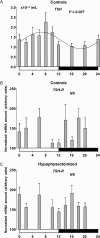Hypophysectomy abolishes rhythms in rat thyroid hormones but not in the thyroid clock
- PMID: 28348112
- PMCID: PMC5446591
- DOI: 10.1530/JOE-17-0111
Hypophysectomy abolishes rhythms in rat thyroid hormones but not in the thyroid clock
Abstract
The endocrine body rhythms including the hypothalamic-pituitary-thyroid axis seem to be regulated by the circadian timing system, and daily rhythmicity of circulating thyroid-stimulating hormone (TSH) is well established. The circadian rhythms are generated by endogenous clocks in the central brain oscillator located in the hypothalamic suprachiasmatic nucleus (SCN) as well as multiple peripheral clocks, but information on the existence and function of a thyroid clock is limited. The molecular machinery in all clock cells is composed of a number of clock genes and their gene products are connected by autoregulatory feedback loops. Here, we provide evidence for a thyroid clock in the rat by demonstrating 24-h antiphase oscillations for the mRNA of the canonical clock genes Per1 and Bmal1, which was unaffected by hypophysectomy. By immunostaining, we supported the existence of a core oscillator in the individual thyroid cells by demonstrating a daily cytoplasmatic-nuclear shuttling of PER1 protein. In normal rats, we found a significant daily rhythmicity in the circulating thyroid hormones preceded by a peak in TSH. In hypophysectomised rats, although the thyroid clock was not affected, the oscillations in circulating thyroid hormones were abolished and the levels were markedly lowered. No daily oscillations in the expression of TSH receptor mRNA were observed in neither control rats nor hypophysectomised rats. Our findings indicate that the daily rhythm of thyroid hormone secretion is governed by SCN signalling via the rhythmic TSH secretion rather than by the local thyroid clock, which was still ticking after hypophysectomy.
Keywords: HPT axis; circadian rhythms; clock genes; pituitary; thyroid hormones.
© 2017 The authors.
Figures




Similar articles
-
Diurnal rhythmicity of the canonical clock genes Per1, Per2 and Bmal1 in the rat adrenal gland is unaltered after hypophysectomy.J Neuroendocrinol. 2008 Mar;20(3):323-9. doi: 10.1111/j.1365-2826.2008.01651.x. Epub 2008 Jan 16. J Neuroendocrinol. 2008. PMID: 18208549
-
Hypothyroidism alters the rhythmicity of the central clock, body temperature and metabolism: evidence of Bmal1 transcriptional regulation by T3.J Physiol. 2024 Oct;602(19):4865-4887. doi: 10.1113/JP286449. Epub 2024 Sep 15. J Physiol. 2024. PMID: 39277824
-
Expression of the clock genes Per1 and Bmal1 during follicle development in the rat ovary. Effects of gonadotropin stimulation and hypophysectomy.Cell Tissue Res. 2012 Dec;350(3):539-48. doi: 10.1007/s00441-012-1489-2. Epub 2012 Sep 1. Cell Tissue Res. 2012. PMID: 22940729
-
Thyroid circadian timing: roles in physiology and thyroid malignancies.J Biol Rhythms. 2015 Apr;30(2):76-83. doi: 10.1177/0748730414557634. Epub 2014 Nov 19. J Biol Rhythms. 2015. PMID: 25411240 Review.
-
[The roles of clock genes in obesity].Nihon Rinsho. 2013 Feb;71(2):244-8. Nihon Rinsho. 2013. PMID: 23631200 Review. Japanese.
Cited by
-
Interconnection between circadian clocks and thyroid function.Nat Rev Endocrinol. 2019 Oct;15(10):590-600. doi: 10.1038/s41574-019-0237-z. Epub 2019 Aug 12. Nat Rev Endocrinol. 2019. PMID: 31406343 Free PMC article. Review.
-
Circadian clock, diurnal glucose metabolic rhythm, and dawn phenomenon.Trends Neurosci. 2022 Jun;45(6):471-482. doi: 10.1016/j.tins.2022.03.010. Epub 2022 Apr 21. Trends Neurosci. 2022. PMID: 35466006 Free PMC article. Review.
-
Circadian Rhythm Effects on the Molecular Regulation of Physiological Systems.Compr Physiol. 2021 Dec 29;12(1):2769-2798. doi: 10.1002/cphy.c210011. Compr Physiol. 2021. PMID: 34964116 Free PMC article. Review.
-
The Circadian Clock Is Sustained in the Thyroid Gland of VIP Receptor 2 Deficient Mice.Front Endocrinol (Lausanne). 2021 Sep 1;12:737581. doi: 10.3389/fendo.2021.737581. eCollection 2021. Front Endocrinol (Lausanne). 2021. PMID: 34539582 Free PMC article.
-
Circadian clock disruption in autoimmune thyroiditis.Eur Thyroid J. 2023 Aug 25;12(5):e230035. doi: 10.1530/ETJ-23-0035. Print 2023 Oct 1. Eur Thyroid J. 2023. PMID: 37548297 Free PMC article.
References
MeSH terms
Substances
LinkOut - more resources
Full Text Sources
Other Literature Sources

